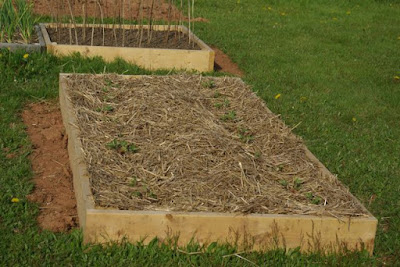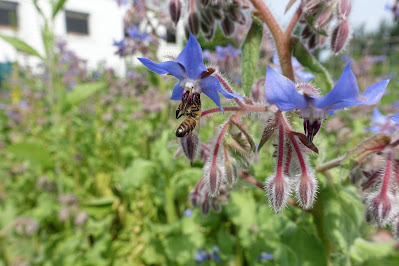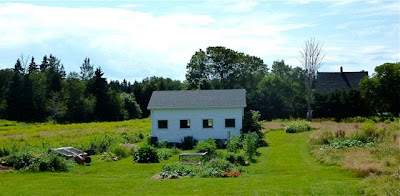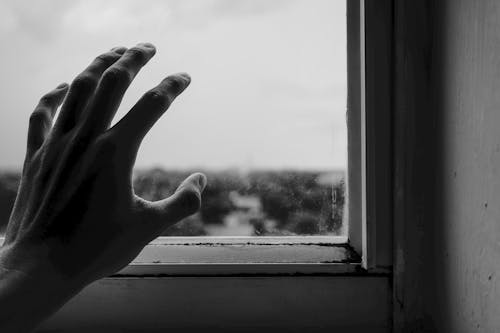 |
| Yes that tomato is 1 lb 5oz! |
I know you've been waiting. Those who have read this blog over the years know I do a tomato review at the end of the season. I love heritage tomatoes. There is so much variety. You can pick from an assortment of attributes such as taste, size, colour - there's a tomato for everyone. When I had to decide what I wanted to grow for seed this year I had a hard time choosing. Some are old favourites but I also gave a few new plants a try.
On a side note, I used red plastic mulch this year to see if worked to ripen fruit earlier. Advertising says it does but in my garden it had no effect. Instead I found the sun created a greenhouse effect and weeds grew very well under the plastic sheeting causing it to rise like a ghost in the garden. Certainly not what the advertisers proclaimed.
What did work well was bio film. This black film is made out of biodegradable products like cornstarch and not only kept weeds at bay but made a recognizable difference in the health of the plants. I occasionally have trouble with early blight and there was not a spot to be found this year. But I digress - on to the tomatoes!
Minis
I'll start with the smallest. You may have heard me list all the things I love about Mexico Midgets before but I'm here to tell you again. These tiny little morsels are simply packed with sweet flavour. The size of a blueberry they are excellent for fresh snacking or sprinkling across a salad. They work well in pita pockets too.
I will admit the plant is not small. Unlike most tomato plants the Mexico Midget grows more like a shrub in a horizontal direction. Branches will grow up to ten feet if you let them. I would suggest regular pruning to keep the plant in check and the fruit accessible.
Yellow Pear is another regular favourite. They look like miniature pears with a bright citrus flavour. Super cute and they taste good.
These tomatoes are aggressively healthy. Indeterminate plants reached up to 8 feet high in my climate before frost finally killed them back. Even after frost green tomatoes ripened and produced more tomatoes than I could pick.
Sugar Lump is a cherry tomato I have tried in the past and I gave it another go this year. While I liked the meaty texture and ultra sweet flavour our tomato connoisseur was not as impressed. Himself prefers a more acid taste. I found the plants grew very quickly but weren't unusually tall - 4 feet at their maximum - and produced nice clusters of fruit, albeit a little late.
Acadian Cherry is a diminuitive plant. Barely 6 inches tall the plants are very sturdy and produced clusters of tart fruit. But you can't produce much when you're so small. Jody loved the flavour of these, and I admit they would make great plants for baskets, but there's just not a lot of tomato for each plant and they were late to ripen so I'm not sure I'll try these again.
Black Plum is possibly my favourite tomato ever. They are susceptible to blossom end rot which is a shame but with a little care produce amazing tomatoes whose flavour cannot be beat. They are a purple tomato with dark green shoulders that has a bold smokey flavour. They make a perfect sun dried tomato or addition where you want a big punch of rich tomato flavour.
Mid-Size
So I know I just said Black Plum was my favourite but for a big tomato Cosmonaut Volkov is my other favourite. It's early, productive, and healthy. Everything you want in a tomato plant. Not only does it produce early, it keeps producing. Perfectly round gorgeous red fruit that can weigh close to one pound each. For value there's nothing like it but they also taste wonderful. Just like a tomato should.
I've grown Copia before and was frustrated with the difficult plants. They are susceptible to early blight, fruit produced late, the stems were brittle and broke easily. So why try them again? Because they taste AMAZING. Jody called them the champagne of tomatoes and the taste cannot be beat. For a fresh BLT this is the tomato you want. They have a bright citrus flavour that's acidic and melts in your mouth.
Plus they're beautiful. Bright yellow with red striping both inside and out. For this reason I'm working on the seed - collecting only the best and hoping the plant health improves because this tomato is worth it.
A new challenge this year was Ruth's Perfect Tomato. They were supposedly the perfect red round tomato. Plants were definitely healthy but the fruit experienced some issues, such as blossom end rot. It was also the last to ripen in my climate and I found myself cropping plant tops in attempts to get them to ripen before the weather got too cold. Generally the tomatoes were a good size, taste and colour but there was nothing wonderful about them and considering the other complications I wasn't impressed.
The last tomato was also a new to me challenge. Amish Paste is known as the largest paste tomato out there and surely it was a monster. In fact it did not look or taste like any paste tomato I've ever grown. Indeterminate plants were 6 feet in height but were quickly pulled down by giant fruit. The tomatoes themselves were plagued by stink bugs which suck the fruit juices, and blossom end rot. The fruit was also inconsistent, to the point where I wondered if there were multiple plants growing together. Some were perfectly round, while others had the more traditional paste tomato shape. I'm not overly fond of paste tomatoes anyway so the flavour and texture wasn't something I was impressed with. I think I'll stick to more traditional paste tomatoes in the future.
 |
| welcome to tomato alley |
That's a wrap for the 2022 season. I hope you enjoyed this and let me know if there's a favourite tomato you have that I should try next year!



.JPG)















.jpg)


.jpg)
.jpg)

.jpg)
.jpg)



















/cdn.vox-cdn.com/uploads/chorus_image/image/15438213/gay_pride_flag.0.jpg)


